| Apr-21-09 | | whiteshark: <37.c3> was a terrible blunder, but Tarrasch missed to win by force with <37...dxc3> 
click for larger view (threats are now Rxf2 and Qxg4) <38.Qb6 Qf4+ 39.Kh3 Qf1+ 40.Kh4 Qf2+ 41.Qxf2 Rxf2 42.bxc3 d4!  > > 
click for larger view |
|
Aug-01-22
 | | KEG: A very curious game. If the game score is to be believed (and there are alternative versions of some games, not this one), Tarrasch outplayed Albin, obtained a won game, blew the win at least four or five times, and played a horrendous ending in which be blundered away the game repeatedly but Albin missed the win every time. Of course, all this is possible, and Tarrasch was clearly out of form at this tournament after a four-year layoff following his triumph at Vienna 1898, but I suspect that something is amiss with the score. In my commentary on the game, however, I will take the text as reported in the Tournament Book and on this site as gospel. Meanwhile, full credit to <whiteshark> on this site for pointing out the blunders by both sides on move 37. Neither of these blunders were noted in the Tournament Book. Bravo <whiteshark> 1. e4 c5
Tarrasch was in the midst of a major comeback after losing three of his first four games (and drawing the fourth) at this tournament. Since then, he had won five games and tied two, including his seventh round game against Albin which was replayed here with colors reversed. By playing the Sicilian, Tarrasch made it clear he was playing for a win. In his four games against Albin, Tarrasch had won two, lost one, and drawn one. They played twice at Monte Carlo 1903, Tarrasch winning both times. 2. Nc3
Albin opted for a Closed Sicilian. One gets the impression he was happy to obtain a draw against so formidable an opponent. 2... Nc6
3. Nf3 e6
4. Be2

click for larger viewSound but hardly enterprising.
4... Nf6
5. 0-0 Qc7
Tarrasch was already planning a King's side attack, and thus shunned such sound moves as 5...Qb6; 5...d5; and 5...e5. 6. Re1
The best way to counter Tarrasch's last move would have been with 6. d4. But Albin wanted a closed solid game and not a tactical shoot-out with Tarrasch. 6... a6
A fine prophylactic move. 6...Be7 was also good. In either case, Black has achieved near equality, and is set to spring his attack. 7. a4 b6
Tarrasch wanted to get his Bishop on b7 in preparation for the attacking plan he was hatching. 8. Bf1
Taking caution to an extreme. 8. d4 looks clearly best. The position was now: 
click for larger viewWhite's position remains safe, and chances were still about equal. But most of us try to do more with the White pieces. 8... Bb7
9. d3 Bd6
With an attack in mind, Tarrasch by-passed the safe but placid 9...Be7. 10. g3 Ne5
Many would just play 10...0-0 here, and that is certainly fine. But Tarrasch was playing for a win, and wanted to get rid of White's f3 Knight. 11. NxN BxN
12. Bg2 h5
Tarrasch's attack begins:
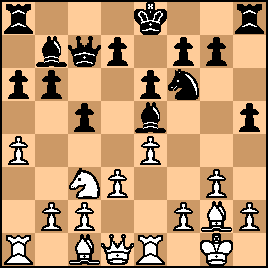
click for larger viewSo far, no meaningful mistakes by either side.
13. Ne2
Perhaps preparing a little trap that--as Albin was to recognize just in time--wouldn't work. 13... h4!
Continuing his attacking scheme and seemingly falling into Albin's little trap: 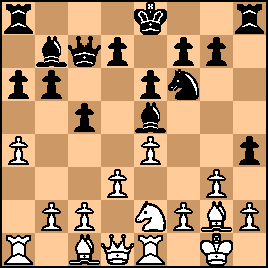
click for larger viewAt first glance, it might appear that Tarrasch had erred and that White could now win with 14. f4 followed by 15. e5. But, as will be seen, Tarrasch was fully prepared for that. |
|
Aug-02-22
 | | KEG: Post II
14. f4?
Since the idea of winning a piece with 14. f4 and 15. e5 is flawed, this move, though hardly a losing blunder (plenty of those coming up in this game!) was a mistake. Better and sufficient for approximate equalty were 14. c3 or 14. c4. 14... Bd6
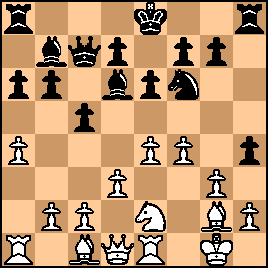
click for larger view15. Nc3
Perhaps only now did Albin recognize that 15. e5 would be a mistake: 15. e5 BxB! 16. Nc3 [The Tournament Book here considered only 16. KxB??, which gets White mated straightaway: 16...Qb7+ 17. Kg1 (or 17. Kf2 Ng4+ 18. Kg1 or Kh1 h3! and mate next move] 16...Qc6 17. Qd2 Bh1 (17...Bf3 is also a killer) 18. exN gxf6 19. Ne4 hxg3 20. hxg3 (20. KxB Rxh2+ would be even worse) Be7 and White, though for now only a pawn down, is clearly busted. The text (15. Nc3), though not quite sufficient for equality, was the best available to White. 15... hxg3
16. hxg3 Be7
16...0-0-0 immediately or 16...e5 were perhaps even stronger, but the text is consistent with Tarrasch's methodical attacking style. 17. Be3
17. Bf3 or maybe 17. Kf2 or even 17. Qe2 may have been slightly better, but in any case White faces a dangerous attack. 17... 0-0-0
17...d5 was also strong, but after the text White was--though not lost by any means--under severe pressure, the kind of pressure Tarrasch was known for inflicting on his opponents when at his best. The position after 17...0-0-0 was: 
click for larger view18. a5
Albin surely had to try something to slow down the Tarrasch juggernaut, but the Tarrasch brushed aside the text with ease. Perhaps 18. Qf3 was a superior try. 18... b5
19. Qe2
19. Qf3 might be slightly better.
19... d5

click for larger viewThe full logic of Tarrasch's plan was now coming into view. What is White to do. 20. e5
After this move, White may be theoretically lost. He probably could hold the game with 20. exd5, but even then White's game would be hanging by a thread: e.g., 20...Nxd5 21. NxN RxN! [this exchange sac is even stronger than 21...BxN] 22. Bf3 [if 22. BxR BxB 23. Kf1 Bf6 White's task of trying to save the game would be even more onerous] Bf6 23. c4 Rxd3 [yet another exchange sacrifice in the offing] 24. QxR BxB 25. Rac1 b4 and White, despite his exchange for a pawn, would be lucky to save the game. 20... Nh5

click for larger viewThis may or may not be a theoretical win for Black, but over the board a human is likely to wilt under the assault (and the dreadful open h-file). In practice, Albin was unable to find his way to safety, and only a stumble a few moves down the road by Tarrasch with the move-30 time control looming allowed Albin to stave off catastrophe. That all being said, this game--based on the score--to this point had been fairly well-played (especially by Tarrasch) and the blunderfest that was to come beginning at move 37 (again, assuming the correctness of the score) had yet to rear its ugly head. |
|
Aug-02-22
 | | KEG: Post III
21. Bf2
Quite a complex position! I played this out many times against myself and against my computer and Black always won. 21. g4 is one of White's best attempts. But after 21. g4 Ng3 22. Qf3 d4 23. QxB+ QxQ 24. BxQ+ KxB 25. Kg2 dxN 26. bxc3 c4 White is in trouble: e.g., 27. Bb6 Rd7 28. Re3 Bh4 29. Bd4 cxd3 30. cxd3 Kc6 White has no easy way to regain the piece and is probably lost. I finally concluded that White's best chance was a violent counter-attack and sacrifice: 21. Nxb5?! axN 22. a6 Bc6 23. Qf2 Qd7 [interesting is 23...Nxg3 24. QxN Bh4 25. Qf3 BxR 26. RxB Qa5 27. c3 Qxa6 28. Bxc5 after which White, though down the exchange, would confront Black with a difficult win. Whatever is best, Albin's 21. Bf2 allowed Tarrasch's attack to pick up stream. It surely can't be best. 21... g5!
Of course:
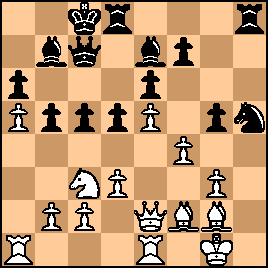
click for larger view22. Bf3?
Here Albin cracked under the pressure. 22. fxg5 (or maybe 22. Qf3) were all that was left for him. 22... Ng7!
A wonderful (quiet) winning move by Tarrasch.
23. fxg5
White has no choice here.
23... Bxg5
For quite a while, I was convinced that this was a mistake and that 23...Nf5 was the way to win. But after considerable study (and some help from my silicon friends) I recognized that Tarrach's simple move is best---and wins. 24. Kg2
I had thought that 24. d4 refuted Tarrasch's 23rd move, but I was wrong. 24... Nf5
Now it was time for this move, and it should have been devastating. 25. Rh1
Pretty much forced, and leaving:
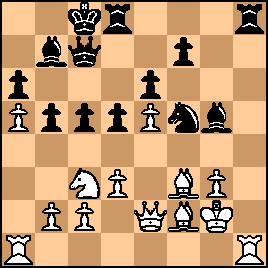
click for larger view25... Nd4
This initially looks good and still almost certainly is sufficient to win, but the simple 25...Rhg8 was even stronger. The next several moves were forced by both sides: 26. BxN cxB
27. RxR RxR
28. Nd1

click for larger view28... Rg8
29. Nf2

click for larger viewTo this point in the game, Tarrasch's play had been of a very high order. But here, with the move-30 time control approaching, Tarrasch got hasty: 29... Bf4!
This gave Albin a chance to regroup. The winning move, 29...Kb8 bringing the King off the c8...a3 diagonal, was hard to find, especially with time on the clock running out. (I only "discovered it" thanks to my computer). But no Albin was back in the game: 30. Ng4
Obviously forced.
30... Bxg3
31. KxB
Again forced.
31... f5
32. Rh1 fxN
33. Bxg4 Kb8

click for larger viewAlbin's position remained difficult, but it was no longer lost. However, it was beginning here that the play recorded in the game score got sloppy--and then awful. The balance of the recorded game is not for the faint of heart. |
|
Aug-02-22
 | | KEG: Post IV
34. Rh5
34. Re1 was perhaps best, but in either case Albin remained very much in the game. 34... Qxa5
Even better was 34...Qg7, going on the attack rather than pawn snatching. 35. Qf2 Qb4
36. Rh7 Rf8
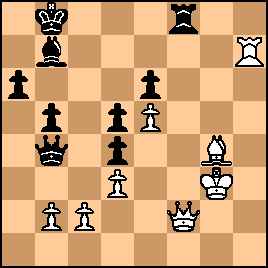
click for larger view37. c3?
"A terrible blunder." (<whiteshark>) Indeed it was, though the Tournament Book did not notice this. Neither did Tarrasch given his recorded reply. The position after 37. c3? was:
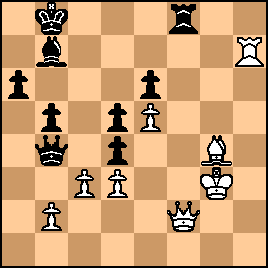
click for larger viewBlack to move and win:
37... RxQ?
Throwing away the win that--as <whiteshark> has shown--was now there for the taking. The winning line, as correctly given by <whiteshark> but missed by the players and by everybody else until his pot, was 37...dxc3 38. Qb6 [Tarrasch may have feared this move, which at first blush seems to be winning, but the pretty line given by <whiteshark> makes everything clear: 38...Qf4+ [forced but winning] 39. Kh3 [39. Kh4 is even worse] 39...Qf1+ 40. Kh4 Qf2+ 41. QxQ RxQ 42. bxc3 d4 (even better is 42...Rh2+_. 38. cxQ

click for larger view38... Rd2
Not 38...Rxb2? 39. Bxe6 and suddenly White has winning chances. 39. Bxe6 Rxd3+
40. Kg4 Re3
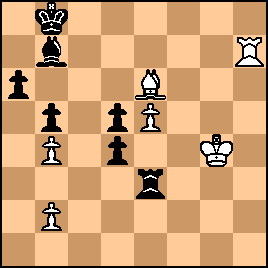
click for larger viewQuite an interesting Rook and Bishop ending. Both sides have Queening threats and both monarchs are exposed. But now play deteriorated fast:
41. Bf5?
I don't get it. Why would White abandon his e-pawn, which just happens to be his only real threat. 41. Kf4 was plainly best. Even 41. Kf5 was much better than the text, and probably sufficient to draw. After Albin's blunder, Tarrasch had at least two ways to win, the position now being: 
click for larger viewNow Tarrasch could just play 41...Rxe5. And 41...d3 is also strong. But instead, Tarrasch played the incomprehensible: 41... Re2?
This left:

click for larger viewNow, White is fine after 42. Rh8+ Kc7 43. Kf4. But, for whatever reason, Albin blundered again with: 42. b3? 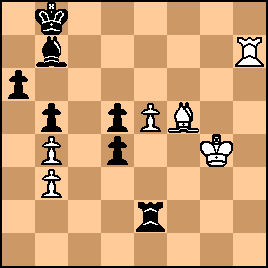
click for larger viewFrom here, astonishing as it may be to believe, play got worse...much worse. |
|
Aug-03-22
 | | KEG: Post V
The winning move for Black (42...Rxe5) is hardly difficult to find. But here, if the score is to be believed, Tarrasch not only blew the win; he gave Albin a simple way to win: 42... Bc8??

click for larger viewI know the move 45 time control was approaching, but even at blitz the text would be atrocious. It turns a win into a loss, the position now being: 
click for larger viewWhite to move and win.
Not very hard is it? 43. Rh8 wins easily after 43...Rxe5 44. RxB+ Ka7 45. Rh8 Re2 46. Rh3. But Albin, inexplicably played:
43. BxB??
Not the game was a very likely draw after:
43... KxB

click for larger viewA draw you say? Not for long:
44. Rh3?
Again, hard to believe. Had everybody forgotten about the White e-pawn. With 44. Kf5, Albin should be able to hold the draw, but now the position was: 
click for larger viewNow Tarrasch had two ways to win: (i) he could bring his King to block the White e-pawn with 44...Kd7, later win the White e-pawn, and then play to promote his d-pawn; or (ii) much more simply, just play 44...Rxe5. But Tarrasch, incredibly, played:
44... Re4+?
Even stranger than Tarrasch's move is the comment in the Tournament Book that Black can win here with 44...Rf2. That move would indeed win if White responded (as the Tournament Book suggests he would) with 45. Kg5?? since Black then wins with 45...Kd7 (or 47...Kd8). But why would White do that when the game is now saved with 45. Rh6. Did everyone go mad looking at the position?
After Tarrasch's 44...Re4+, Albin was forced to save his e-pawn with: 45. Kf5
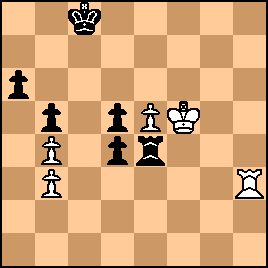
click for larger viewNow, yet again, the game seemed headed for a draw. But the madness was far from over: 45... Re3
46. Rh8+ Kd7
47. Rh7+

click for larger viewNow, the really zany part of the game was set to unfold. 47... Ke8?
Huh. Walking into a near mating net. Tarrasch would have been fine with 47...Kc6 or even 47...Kc8. And the move-45 time control had been reached. Yet, Tarrasch marched his King to the one square where Albin would have a likely win. 48. Ke6
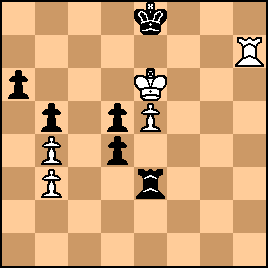
click for larger viewHow could Tarrasch have let this happen? First he declined to win the White e-pawn and let it become a threat, and then his King moved to the one square where it could be threatened with mate. Sad to say, the insanity did not end here. |
|
Aug-03-22
 | | KEG: Post VI
48... Kf8
Desperately trying to stay alive, but with decent play by Albin, Tarrasch should lose. 49. Rf7+ Kg8
50. Rd7

click for larger viewThings looked awful for Tarrasch here.
50... d3
Worth a shot, though hopeless against best play. 51. Rxd5 Kg7

click for larger view52. Rd8?
This flubs the win. The winning line begins with 52. Rd6 allowing both the capture of the Black a-pawn in some variations and the White King to cross BEHIND the White Rook in others. But Albin erred once again, leaving the following position: 
click for larger viewNow Tarrasch's King can run to safety with 52...Kg6 (e.g., 53. Rd6 Kg5, etc.). But instead, based on the game score, Tarrasch blundered once again with: 52... Rh3?
This left:
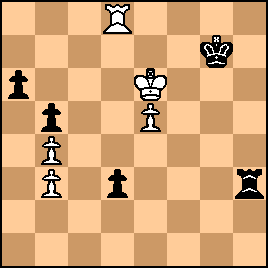
click for larger viewNow White rolls to victory with 53. Ke7 (e.g., 53...Kg6 54. Rd6+ Kf5 55. e6 Re3 56. Kd7 Kf6 57. Rxa6 d2 58. Re6 Re2 59. e7+ Kf7 60. e8(Q) RxQ 61. Rd2 after which with the Black King cut off White wins.). But instead, Albin played:
53. Rd4

click for larger viewThis is probably still a theoretical win for White, but now more work is required. 53... Kf8
53...Kg6 was probably a better practical chance for Black. After 53...Kf8, the position was:
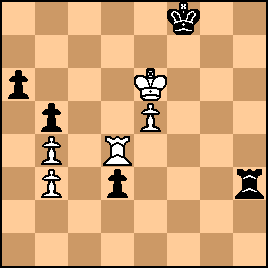
click for larger view54. Kd7
The Tournament Book claims that the text was a mistake and that 54. Rd8 wins. In fact, both moves do the trick for White. Albin's mistake came on his next move. 54... Rh7+
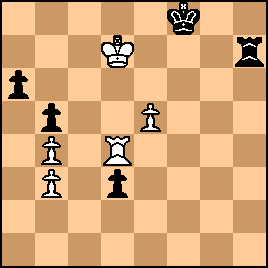
click for larger viewHere, with the win so close, Albin messed up yet again and gave Tarrasch yet another chance to draw. But not to worry, Tarrasch was to blunder again and give Albin one more chance to win. But then Albin made his final mistake and allowed Tarrasch to draw. I will attempt to cover this less than brilliant finale in my next post on this game. |
|
Aug-03-22
 | | nizmo11: I was thinking that perhaps White's move 40. was the more natural looking <40.Kf4> and not 40.Kg4, and so the game continued 40. Kf4 Re3 41. Bf5 Re2 42. b3 Bc8 (now not losing piece) 43.Bxc8 Kxc8. This would avoid the multiple blunders on those moves, leading to the following position on the move 44:
click for larger viewBut then the next problem: If this position actually occurred in the game then another pair of mutual errors still occurred: 44.Rh3? (44.Kf5, Rh6, Rh8+ all draw) 44...Re4? (44...Rf2+! and Black wins!). Regardless if this has any relevance to the game, I find this is a very interesting position. After 45. Kg4!
(45.Kg5 Kd7! 46.Rh6! d3! 47.Rxa6 d2 and White King is too far away)

click for larger view
With king at g4 White draws after 45...Kd7? 46. Rh6!, and Black would need to find the very subtle 45...Rf1! setting White in zugzwang. |
|
Aug-04-22
 | | KEG: <nizmo11>Thank you for your intriguing post. As you note, if White's actual 40th move was Kf4 rather than Kg4, moves 41 through 43 make sense. Among other things, your reconstructed line explains 42...Bc8, which would no longer be a piece-losing blunder since now 43. Rh8 would lose to 43...Rf2+. But, as you likewise point out, 44. Rh3? would still be a hard-to-explain losing blunder, whereas the natural 44. Kf5 would have held for White. Following through on your fascinating line in your analysis; after 44. Rh3 Rf2+ 45. Kg4, Black has in addition to the winning move you identify (45...Rf1) an alternative way to win: 45...Rf8 With that exception, I agree with your reasoning. So maybe 40. Kf4 (and not 40. Kg4) was played. If so, it does explain SOME of the madness in the official score. But other problems remain, and--if the balance of the score is correct after your revision--it still has Tarrasch playing like a lox (and Albin as well). You may have salvaged a bit of the score, and for that I thank you. But--as an admirer of Tarrasch--I still find what remains deeply disturbing. |
|
Aug-04-22
 | | nizmo11: if 40.Kf4 was played, it would also salvage the Tournament Book comment that Black can win with 44.Rf2 (now with a check, so there is no 45.Rh6), and we get the variant with 45.Kg4 Rf1 (or Rf8 as you pointed out).\
I agree with you, the end of the game is very disturbing, especially after the fine attacking play Tarrasch showed at the early stages of the game. |
|
Aug-04-22
 | | KEG: Post VII
After 54...Rh7+, the position was:

click for larger viewPerhaps the approaching move-60 time control played a factor, but (assuming the correctness of the reported score) play now became sloppy. 55. Kd8?
55. Kc6 was the winning line (e.g., 55...Rh6+ 56. Kb7 and now White snatches the Black d-pawn and follows with Rd6 after which both of Black's pawns are lost and the win, though a tad laborious, is not difficult). After the text, Tarrasch should have escaped.
55... Re7
The best try for Black.
56. Rxd3 Rxe5
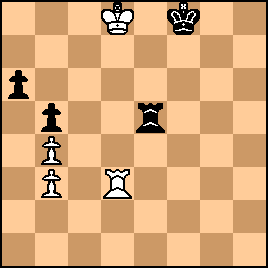
click for larger view57. Rf3+
I initially thought this was a blunder and that 57. Kc6 would win, but my silicon friends have persuaded me that Black can still hold. I tried everything, but ultimately had to concede that the game is drawn with best play. But what followed was hardly best play.
57... Kg7!
Forced. 57...Kg8 loses.
58. Kc7

click for larger view58... Re6?
This loses. Tarrasch had to play 58...Re2 or 58...Re1. After the text, Albin had a seemingly simple win: 59. Kb7 Kg6
60. Rf1 Kg5
61. Ra1

click for larger view61... Kf5
At one point I thought that 61...Re4 would have offered stiffer resistance, but that--like the text--proved to be hopeless. The position was now:
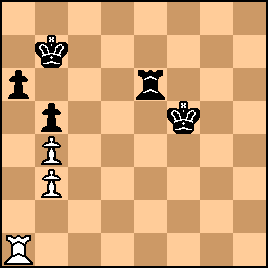
click for larger view62. Rxa6?
The final blunder, allowing Tarrasch to draw. The winning line is 62. Rc6! Kg4 (nothing else is better) 63. Rc6 after which the Black pawns fall and the Black King is cut off: e.g., 63...Re8 64. Kxa6 Kg3 65. Kxb5 and now, although Black can if he likes win the White pawn on b3, the pawn on b4 cannot be stopped in the long run. After 62. Rxa6, the position was:

click for larger viewThe rest was easy for Tarrasch:
62... Re4!
Forced but sufficient
63. Kb6 Rxb4
Unlike what would have occurred after 62. Rc1, Black now wins the b4 rather than the b3 pawn and can draw. 64. Ra3

click for larger view64... Ke6!
Forced.
65. Kc5 Rh4
66. Kxb5

click for larger viewNow, the draw is clear:
66... Kd7
67. b4
Now Black can play 67...Kc8 or 67...Kc7 saving the day. Recognizing the futility of further play, Albin agreed to a draw here. DRAWN
A troubling game, though Tarrasch finally grasped his saving chances at the very end. |
|
|
|
|





